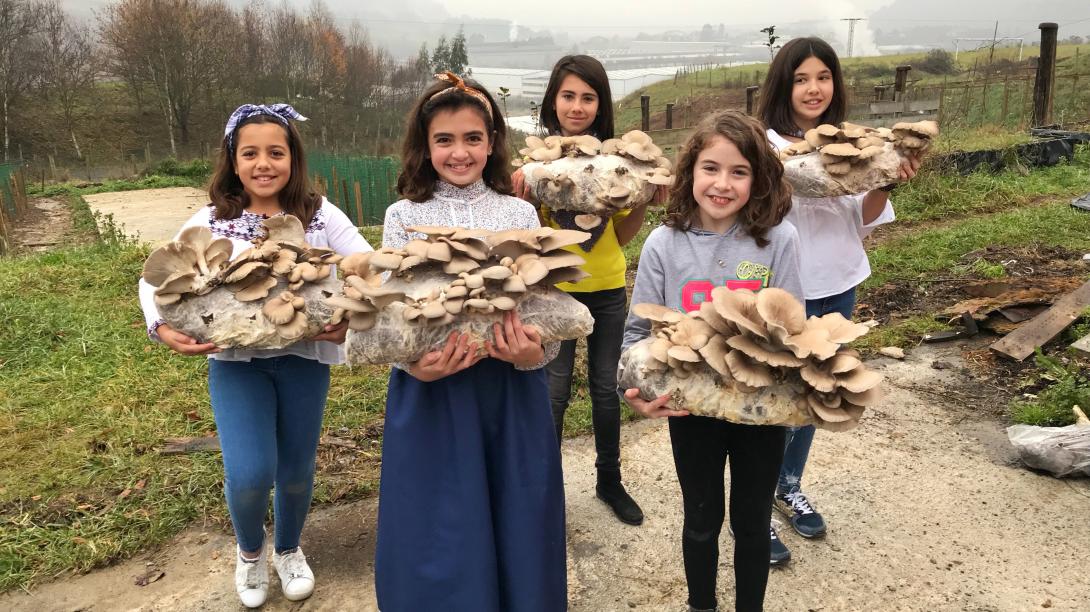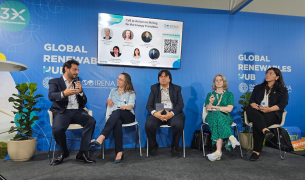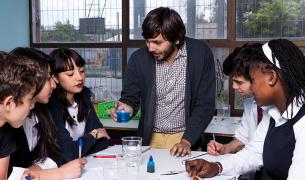Prioritizing climate education is a win-win, not a trade-off

Egoitz Etxeandia Romero, an Empieza por Educar alumnus and high school teacher in Amorebieta, Spain, engages his students in circular economy projects. Through activities like recycling cooking oil to make soap, using coffee grounds to grow oyster mushrooms or repurposing face masks to produce shopping bags, Egoitz aims to build students’ collective agency to solve real-world sustainability issues affecting their community. All the products resulting from the projects are later marketed, with profits financing other projects, creating a financial circular economy. The projects are all interdisciplinary and help students experience the practical relevance of their learning in subjects like science, IT, and math.
Egoitz feels strongly that environmental sustainability, rooted in a firm understanding of the impacts of human actions on our planet, is a vitally important part of his students’ education. However, Egoitz’s innovative drive for preparing students to shape their future is often met with fears that teaching environmental sustainability and climate change in schools will come at the cost of students’ foundational skills, like literacy or numeracy. Such “zero-sum” or “trade-off” logic is rooted in the mindset that there is a fixed amount of time and attention available: administrators and colleagues at Egoitz’s school worry that taking time for climate education will, in turn, result in students receiving less instruction in critical subjects like math and reading. “Every time I go to the [administrators] with a new project that I feel will be a win-win for student’s learning, I face the same challenge,” Egoitz explains. “[They say] ‘That could be important—but the students will lose time for studying physics’ or for yet another mechanical exercise.” With these barriers at his school, Egoitz often needs to work extra hours or use creative workarounds to teach his students about the climate crisis and sustainability.
Many teachers across Teach For All’s global network report being confronted with similar zero-sum concerns when it comes to their climate education plans—this reflects a key barrier to such work in schools. The concerns generally come from a place of well-meaning: fellow teachers and school leaders are protective of students’ learning time and want to ensure that they develop foundational skills, meeting curriculum requirements and established educational standards (which in many countries make no reference to climate change). At the same time, we see many examples from our network that demonstrate how offering quality climate education and fortifying students’ foundational learning is not a trade-off but rather a win-win: Climate education can enhance and reinforce core educational objectives as well as student motivation and 21st century skills, among many other benefits.
Experiences from across the Teach For All network
In July 2022, we held a Teach For All Climate Education Community call on the topic of Addressing the zero-sum mindset about climate education. Teachers of several network partners in countries across the globe shared examples of how such a mindset is a key barrier to their climate education work and how the premises of that mindset are debunked once people witness the impacts of engaging students in climate education. Since this initial conversation starter, teachers continued sharing their examples.
Three central insights emerged from the experiences shared by teachers from across the network:
- Students in many countries deeply experience and care about climate change—as a result, they demand climate education in schools. This trend experienced across our network is reflected by research: in a 2022 survey of over 42,000 children in 15 countries, 83% of children report witnessing climate change or inequality, or both, affecting the world around them and several global surveys show that young people regard the climate crisis as the most important issue for our time (and their future). UNESCO compiled a youth survey with 17,500 respondents in 2022, that illustrated both how unprepared youth feel about climate change and how loud the call is for quality climate change education in schools. Students want to learn and get active on climate change—so far, however, youth largely lead climate action despite, rather than because of, what’s happening in schools.
- Learning is strongest when it’s driven by interest. Students’ great energy for climate action means that climate education can give them a strong sense of purpose and increase their curiosity and activation across school subjects—which boosts overall motivation and school performance.
- Climate education fosters applied and connected learning. Learning the core disciplines with a view towards addressing local environmental challenges and impacts of climate change enables students to connect their learning to their lived experience and apply their knowledge to solve problems they see in their daily context / communities. Teachers also observe students building 21st century skills and mindsets like empathy, collaboration, creativity, entrepreneurship, and communication.
Across the Teach For All network, there are many climate education examples that reflect these three central insights in an integrated way. For instance, Susan, a Teach For Armenia fellow and math teacher, implemented a project called “Second Life to Waste” with her students, which harnessed their passion for climate action to engage them in interdisciplinary thinking and cooperation. Susan believes that practice is the main indicator of learning math. To start off, she asked students, “What does our (school) community need and how can we help?” Based on their initial problem definition, the class created several circular economy solutions, such as recycling and renovating old furniture to a new “eco-room” for the school. Students learned and applied different skills—for example, solving algebraic formulas and financial accounting—to make a difference in their school community. Susan observed that, after participating in the project, students became much more attentive to ways they can connect their learning to the real world and opportunities to use their knowledge to help others. Susan’s students were so energized by the project that they decided to next start a schoolwide paper recycling project. And the students’ work has had ripple effects, in that other community members who helped with the project or learned about it on social media have been inspired to start recycling initiatives themselves.
Cristina, an Enseña por Colombia alumna, started the Vive La Cumbre initiative, which aims to “strengthen the life skills and environmental awareness of young people.” They give students the opportunity to climb a snow-capped mountain and track changes they observe in the landscape (e.g., snowfall patterns) over time. As students face the challenge of hiking up to the peak, they form friendships with a diverse group of students, develop an environmental consciousness, and build social-emotional connections and skills. They also gain opportunities to apply skills they have learned in the classroom, such as scientific investigation and analysis. For Cristina, the mountain—and our natural environment more broadly—is an important “ally” for ensuring a deep, lasting impact on students.
In Zimbabwe, teachers Edson and Obey witness how the effects of climate change—e.g., rising temperatures, drought, soil erosion—are already deeply ingrained into the lived reality of their students. Because their students were strongly motivated to learn how to better prepare themselves and their communities for such effects, both Edson and Obey started school-wide ‘climate action clubs’ and were able to get their whole schools on board to integrate climate change education across students’ learning, earning the support of the headmaster, the chief of the district, and the school district inspector. As their students gain knowledge and skills—and experience self-efficacy—for adapting to the climate crisis, they often move from fear and anxiety about their future to the realization that they can use what they know to overcome challenges and risks.
In the case of Egoitz, his students are really excited about the fact that the circular economy projects give them the agency to help address local environmental issues and climate change. Because these projects are interdisciplinary—for example, his Funghi Thinking project spans seven subjects, namely physics, math, marketing, biology, economics, technology, and communication—students learn to use their learning as a tool for making sense of the world and for problem-solving, in a connected, holistic way. And the projects have had an impact beyond Egoitz’ school: the City Council of Bilbao (a city of 345,000) asked a group of participating students to help advise on the municipality’s circular economy strategy and contacted Egoitz to implement the Funghi Thinking project in other schools, including especially those with students at risk of social exclusion. Teachers in other schools where Egoitz led the project have reported that students involved in them showed higher motivation and engagement, better grades, and improved self-confidence. Egoitz is proud to see the students excel and to witness the deep impact this experience has on their learning. And yet, despite these accomplishments, Egoitz’s circular economy project plans still mostly remain an uphill battle.
New opportunities for climate education
Susan, Cristina, Edson, Obey, and Egoitz, along with many other teachers in and beyond our network, demonstrate the ways that climate education can prepare students to face their significantly climate-changed future with hope, agency, and motivation. Thanks to examples like theirs, we know we have an immense opportunity for sparking collective learning and action on climate change in schools and for building the readiness of today’s and tomorrow’s youth to face their future with a sense of possibility and an innovative spirit. In order to achieve this, it is critical that we address climate change in schools—not as a separate subject, but integrated across subjects, so that students learn how to leverage their learning as a tool for making sense of the world and for engaging in problem-solving.
A zero-sum mindset about climate education, however, is a barrier to doing this work. Rather than competing with other academic objectives, climate education instead should be seen as an important vehicle for reaching those objectives. For this to happen, teachers need to be supported and given space to engage students in meaningful climate education. This starts with the recognition that climate education is a vital part of our core purpose of supporting all students to shape a better future for themselves and all of us.
To continue supporting Teach For All’s 60+ network partners on this path, we have launched the Teach For All Climate Education and Leadership Fund, and we invite interested network partners to propose what they regard as the most meaningful climate education activities that enhance student learning and address sustainability challenges in their context. As we begin this new year, we look forward to continuing to learn from network teachers’ experiences and supporting all of our network partners so that we can further our collective progress in advancing climate education as an integral part of preparing students.



